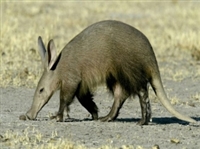5 Unique Animals

1
African aardvark
The most unique living mammal is without doubt the African aardvark, Orycteropus afer, which has a genus, family and order all to itself. It is in fact the only mammal that is the sole representative of an order. That order is ‘Tubulidentata’, meaning ‘tubular teeth’. It has no living relatives and nothing is known of its evolutionary kin. The aardvark (‘earth pig’ or ant-bear) which lives in burrows in the African grasslands, is surprisingly large, weighing up to 70 kg. Its diet consists of termites that it licks up with its 30 cm long, sticky tongue.
2
cheetah
The cheetah, Acinonyx jubatus, also enjoys a genus to itself. It belongs to the cat family, but differs from them in that it is unable to retract its claws like true cats. However, baby cheetahs can do this, but the ability disappears when they are about ten weeks old. Unlike other large felids, cheetahs are remarkably placid (some say they are more dog-like than cat-like in temperament) and have been domesticated as pets since the time of the Ancient Egyptians.
3
panda
The panda (Ailurus melanoleuca) is one of the most famous unique and endangered animal species but few people know that it belongs to the raccoon family. There is only one species of panda, but it belongs in a genus with one other little known panda, found in China and the Himalayas. The red panda bears little resemblance to the cuddly great panda, looking much more like its American raccoon relatives. It weighs only about 5 kg. It can partially retract its claws and is sometimes known as the cat bear.
4
pangolin
The pangolin is another unique animal, even though there are seven species of pangolin, in Africa and southern Asia. These toothless ant-eating animals, with foot-long tongues, are covered in scaly armour. They are not related to South American anteaters and like the aardvark, nothing is known about their evolutionary ancestors.
5
honey badger
The honey badger, or ratel, can boast of being the only member of its subfamily, and the sole member of its genus, Mellivora (meaning ‘honey eater’). Related to the weasels, the powerful and aggressive honey badger will eat animals as large as young antelope but, like Winnie the Pooh, its favourite food is honey. It works together with the Honey Guide bird to locate bee’s nests. It uses its strong claws to rip the nest open, with the bird sharing in the spoils.
Animals like these, and many others, are living testimony to the miracle of nature. Our world would be much poorer without them. Ironically, the biggest threat to these and other creatures is another animal that is the sole living representative of its genus and species: man.
More Top 10 Lists
Worst 5 First-Date Dinner Choices
Top 10 rock vocalists,1970-2012
My top 10 best Countries to live in the World
Top ten questions you need to ask the man you want to start dating....
MARTIAL ART REAL FOUNDER
Top 10 reasons geeks make better lovers.
The Top 10 Reasons, Why Most of Us are Still Single
Men & WOmen
Early sci-fi films
Ten Reasons to find the "right" Partner
More Top 10 Lists
Stats for this Top 10 List
Related Top 10 Lists
- Worst 5 First-Date Dinner Choices
- Top 10 rock vocalists,1970-2012
- My top 10 best Countries to live in the World
- Top ten questions you need to ask the man you want to start dating....
- MARTIAL ART REAL FOUNDER
- Top 10 reasons geeks make better lovers.
- The Top 10 Reasons, Why Most of Us are Still Single
- Men & WOmen
- Early sci-fi films
- Ten Reasons to find the "right" Partner

Comments (1)
Giant pandas are related to bears, while red pandas are said to be more closely related to raccoon. However, new evidences has been discovered that has put red pandas into their own family.